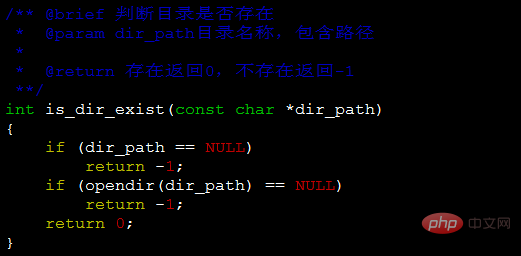 Operation and Maintenance
Operation and Maintenance
 Linux Operation and Maintenance
Linux Operation and Maintenance
 How to determine whether a file exists in Linux
How to determine whether a file exists in Linux
How to determine whether a file exists in Linux

How to determine whether a file exists under Linux:
1. stat series functions
The stat function is used to return structural information related to files. . The stat series functions have three situations, corresponding to file names, file descriptors and symbolic link files respectively. The stat structure describes the file attributes, mainly including file type, file size, etc. The detailed stat structure is as follows:
struct stat {
mode_t st_mode; // file type & mode(permissions)
ino_t st_ino; // i-node number(serial number)
dev_t st_dev; // device number(filesystem)
dev_t st_rdev; // device number for specials files
nlink_t st_nlink; // number of links
uid_t st_uid; // user ID of owner
gid_t st_gid; // group ID of owner
off_t st_size; // size in bytes, for regular files
time_t st_atime; // time of last access
time_t st_mtime; // time of last modification
time_t st_ctime; // time of last file status change
long st_blksize; // best I/O block size
long st_blocks; // number of 512-byte blocks allocated
};We can obtain information such as file type and file size through stat. File types are: ordinary files, directory files, block special files, character special files, FIFO, sockets and symbolic links. If you want to use the stat series of functions to determine whether a file or directory exists, when executing the stat function, if the file exists, you need to further determine whether the file is an ordinary file or a directory file.
The stat series function error returns -1. The error code is stored in errno. The value of errno is as follows:
1. The file specified by the ENOENT parameter file_name does not exist
2. The directory in the ENOTDIR path exists but is not a real directory
3. The file to be opened by ELOOP has too many symbolic links. The upper limit is 16 symbolic links
4. EFAULT parameter buf It is an invalid pointer, pointing to a memory space that cannot exist
5. EACCESS was denied when accessing the file
6. ENOMEM core memory is insufficient
7. The path of the ENAMETOOLONG parameter file_name The name is too long
2. Access function
The access function tests access permissions based on the actual user ID and actual group. The function prototype is:
#include <unistd.h> int access(const char *pathname, int mode);
mode value:
F_OK Test whether the file exists
R_OK Test read permission
W_OK Test write permission
X_OK Test execution permissions
To correctly determine whether a file exists, use the access function. The implementation is as follows:

3. oepndir function
The opendir function is used to open a file directory and returns a pointer if successful or NULL if an error occurs. The implementation is as follows:

(Recommended learning: linux tutorial)
The above is the detailed content of How to determine whether a file exists in Linux. For more information, please follow other related articles on the PHP Chinese website!

Hot AI Tools

Undresser.AI Undress
AI-powered app for creating realistic nude photos

AI Clothes Remover
Online AI tool for removing clothes from photos.

Undress AI Tool
Undress images for free

Clothoff.io
AI clothes remover

Video Face Swap
Swap faces in any video effortlessly with our completely free AI face swap tool!

Hot Article

Hot Tools

Notepad++7.3.1
Easy-to-use and free code editor

SublimeText3 Chinese version
Chinese version, very easy to use

Zend Studio 13.0.1
Powerful PHP integrated development environment

Dreamweaver CS6
Visual web development tools

SublimeText3 Mac version
God-level code editing software (SublimeText3)

Hot Topics
 1386
1386
 52
52
 How to use docker desktop
Apr 15, 2025 am 11:45 AM
How to use docker desktop
Apr 15, 2025 am 11:45 AM
How to use Docker Desktop? Docker Desktop is a tool for running Docker containers on local machines. The steps to use include: 1. Install Docker Desktop; 2. Start Docker Desktop; 3. Create Docker image (using Dockerfile); 4. Build Docker image (using docker build); 5. Run Docker container (using docker run).
 Difference between centos and ubuntu
Apr 14, 2025 pm 09:09 PM
Difference between centos and ubuntu
Apr 14, 2025 pm 09:09 PM
The key differences between CentOS and Ubuntu are: origin (CentOS originates from Red Hat, for enterprises; Ubuntu originates from Debian, for individuals), package management (CentOS uses yum, focusing on stability; Ubuntu uses apt, for high update frequency), support cycle (CentOS provides 10 years of support, Ubuntu provides 5 years of LTS support), community support (CentOS focuses on stability, Ubuntu provides a wide range of tutorials and documents), uses (CentOS is biased towards servers, Ubuntu is suitable for servers and desktops), other differences include installation simplicity (CentOS is thin)
 What to do if the docker image fails
Apr 15, 2025 am 11:21 AM
What to do if the docker image fails
Apr 15, 2025 am 11:21 AM
Troubleshooting steps for failed Docker image build: Check Dockerfile syntax and dependency version. Check if the build context contains the required source code and dependencies. View the build log for error details. Use the --target option to build a hierarchical phase to identify failure points. Make sure to use the latest version of Docker engine. Build the image with --t [image-name]:debug mode to debug the problem. Check disk space and make sure it is sufficient. Disable SELinux to prevent interference with the build process. Ask community platforms for help, provide Dockerfiles and build log descriptions for more specific suggestions.
 How to view the docker process
Apr 15, 2025 am 11:48 AM
How to view the docker process
Apr 15, 2025 am 11:48 AM
Docker process viewing method: 1. Docker CLI command: docker ps; 2. Systemd CLI command: systemctl status docker; 3. Docker Compose CLI command: docker-compose ps; 4. Process Explorer (Windows); 5. /proc directory (Linux).
 What computer configuration is required for vscode
Apr 15, 2025 pm 09:48 PM
What computer configuration is required for vscode
Apr 15, 2025 pm 09:48 PM
VS Code system requirements: Operating system: Windows 10 and above, macOS 10.12 and above, Linux distribution processor: minimum 1.6 GHz, recommended 2.0 GHz and above memory: minimum 512 MB, recommended 4 GB and above storage space: minimum 250 MB, recommended 1 GB and above other requirements: stable network connection, Xorg/Wayland (Linux)
 Detailed explanation of docker principle
Apr 14, 2025 pm 11:57 PM
Detailed explanation of docker principle
Apr 14, 2025 pm 11:57 PM
Docker uses Linux kernel features to provide an efficient and isolated application running environment. Its working principle is as follows: 1. The mirror is used as a read-only template, which contains everything you need to run the application; 2. The Union File System (UnionFS) stacks multiple file systems, only storing the differences, saving space and speeding up; 3. The daemon manages the mirrors and containers, and the client uses them for interaction; 4. Namespaces and cgroups implement container isolation and resource limitations; 5. Multiple network modes support container interconnection. Only by understanding these core concepts can you better utilize Docker.
 What is vscode What is vscode for?
Apr 15, 2025 pm 06:45 PM
What is vscode What is vscode for?
Apr 15, 2025 pm 06:45 PM
VS Code is the full name Visual Studio Code, which is a free and open source cross-platform code editor and development environment developed by Microsoft. It supports a wide range of programming languages and provides syntax highlighting, code automatic completion, code snippets and smart prompts to improve development efficiency. Through a rich extension ecosystem, users can add extensions to specific needs and languages, such as debuggers, code formatting tools, and Git integrations. VS Code also includes an intuitive debugger that helps quickly find and resolve bugs in your code.
 How to switch Chinese mode with vscode
Apr 15, 2025 pm 11:39 PM
How to switch Chinese mode with vscode
Apr 15, 2025 pm 11:39 PM
VS Code To switch Chinese mode: Open the settings interface (Windows/Linux: Ctrl, macOS: Cmd,) Search for "Editor: Language" settings Select "Chinese" in the drop-down menu Save settings and restart VS Code



